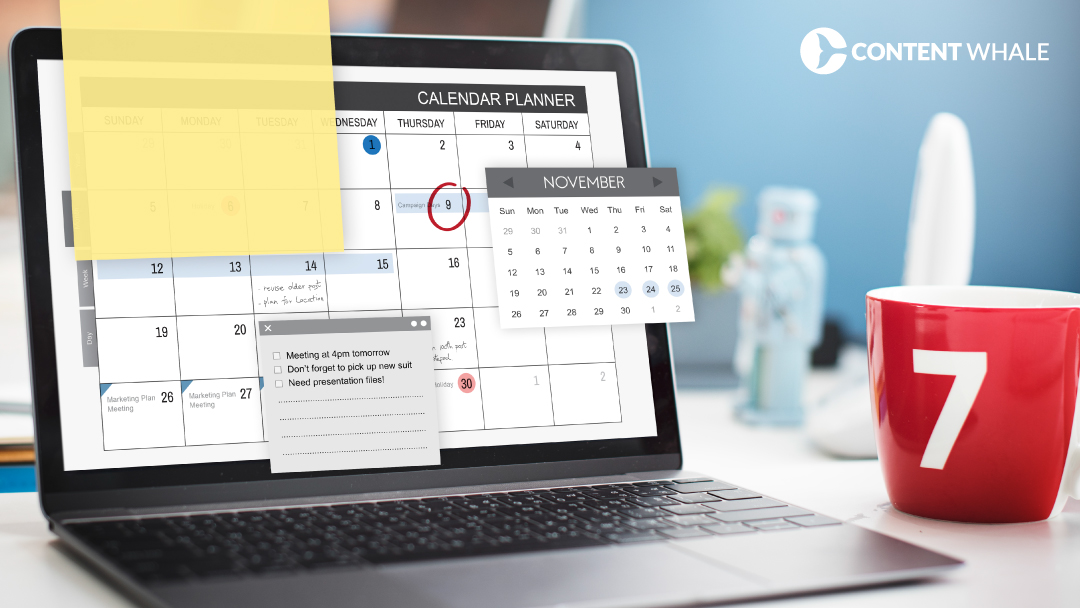Quick Summary
A content calendar is essential for organizing and planning your marketing efforts. Creating an effective content calendar involves following seven content calendar steps: setting clear goals, identifying your audience, choosing the right tools, planning content themes and topics, scheduling your content, assigning responsibilities, and monitoring and adjusting your calendar. These content calendar tips ensure that your strategy is cohesive and effective. Regular updates and analytics help optimize your plan for better results. For expert guidance, Content Whale offers professional services to enhance your content strategy and help you achieve your marketing goals.
A content calendar is a strategic tool that outlines what content will be published and when. Creating an effective content calendar is essential for maintaining consistency and aligning your marketing efforts. According to the Content Marketing Institute, 63% of businesses do not have a documented content strategy, which significantly impacts their ability to achieve their marketing goals.
Do you know that 72% of marketers who use a content calendar report higher efficiency in their content creation processes? A well-structured content calendar helps you plan ahead, ensuring you always have fresh content ready to publish. According to HubSpot, companies with a documented content strategy are more likely to succeed in their marketing efforts.
This guide will cover the essential content calendar steps you need to follow to create a robust plan. We’ll explore how to create a content calendar in seven simple steps and provide practical content calendar tips to streamline your content planning process. By following these steps, you’ll enhance your marketing strategy and drive better results.
Step 1: Set Clear Goals

Defining your content goals is the first step in creating an effective content calendar. These goals should align with your overall marketing objectives, such as increasing brand awareness, generating leads, driving website traffic, or boosting engagement.
According to CoSchedule, marketers who set specific goals are more likely to report success. Goals provide direction and help measure success. For instance, if your goal is lead generation, tailor your content to attract and convert potential customers. Research from Sprout Social emphasises that clear, measurable goals enhance team productivity and effectiveness.
By setting SMART (Specific, Measurable, Achievable, Relevant, Time-bound) goals, you ensure your content plan is focused and results-driven. Specific goals enable better resource allocation and clearer strategy execution, driving meaningful results for your business.
Implementing these content calendar tips and following the content calendar steps will optimize your content strategy and overall marketing efforts.
Step 2: Identify Your Audience

Understanding your target audience is crucial for creating an effective content calendar. Begin by researching audience demographics, preferences, and behavior patterns. Tools like Google Analytics, social media insights, and customer surveys offer valuable data. According to Harvard Business School, 68% of consumers expect personalised experiences, emphasising the importance of knowing your audience.
Analysing your current customer base is a great starting point. Look at demographics, purchase history, and engagement metrics to identify patterns. For example, if your audience consists of young professionals, focus on content relevant to their career growth and lifestyle. Market research and competitor analysis can also uncover valuable insights and gaps in the market.
Using this data, create detailed audience profiles. These profiles help tailor your content to meet the specific interests and needs of different segments, enhancing engagement and effectiveness. Aligning your content with your audience’s preferences builds stronger connections and drives better results.
Step 3: Choose the Right Tools

Selecting the right tools is essential for creating an effective content calendar. Tools like Trello, Asana, and Google Calendar offer features to help you organize, schedule, and track your content efficiently. Trello provides a user-friendly interface with customizable boards to manage tasks and deadlines visually. Asana supports multiple views, such as list and calendar formats, and offers collaborative workflows to streamline team efforts.
For a more feature-rich option, consider ContentStudio, which integrates with various social media platforms and offers analytics to monitor engagement. Smartsheet is another robust tool ideal for advanced organisations, with features like automated task reminders and proofing collaboration. If your budget allows, Canva Pro combines design and scheduling capabilities, making it a cost-effective choice for visually driven content strategies.
When choosing a tool, consider your team’s workflow, the complexity of your content strategy, and your budget. The right tool will enhance collaboration, ensure timely content publication, and maintain quality standards.
Here is a table summarizing the features and benefits of various tools for managing a content calendar:
| Tool | Key Features | Ideal For | Pricing | Reviews |
|---|---|---|---|---|
| Trello | User-friendly interface, customizable boards, color-coding, calendar view, task assignment | Small to medium teams | $6 per month (basic) | Simple, intuitive, but requires third-party integrations for automation |
| Asana | Multiple views (list, calendar, timeline), collaborative workflows, automated processes | Teams needing detailed project management | Free to $24.99 per user/month | Highly rated for collaboration and automation |
| Google Calendar | Basic scheduling, easy integration with other Google tools | Individuals and small teams | Free | Basic features but very accessible |
| Smartsheet | Spreadsheet-based, color-coding, automated reminders, proofing collaboration | Advanced organization needs | $14-$25 per user/month | Great for detailed organization and project management |
| ContentStudio | Visual calendar, social media integrations, analytics, AI assistant for content creation | Social media managers, content teams | $25-$99 per month | User-friendly, excellent for social media management |
| Canva Pro | Design and schedule content, integrates with social media platforms | Visually-driven content strategies | $12.99/month or $119.99/year | Affordable, great for integrated design and scheduling |
I) Trello: This tool is best for small to medium-sized teams looking for a simple, visual way to manage tasks and deadlines. Customisable boards and a calendar view make it easy to organise content, though automation requires third-party integrations.
II) Asana: It is Ideal for teams needing detailed project management with multiple view options and strong collaboration features. It supports complex workflows and automation, making it suitable for larger teams.
III) Google Calendar: A straightforward, free option for individuals or small teams needing basic scheduling without additional project management features.
IV) Smartsheet: Smartsheet is suitable for advanced organizational needs, offering features like automated reminders and proofing collaboration. Its spreadsheet format is familiar to many users and supports detailed project tracking.
V) ContentStudio: Excellent for social media managers and content teams needing robust social media integrations, visual planning, and analytics. The AI assistant helps generate content ideas, making it a versatile tool for comprehensive social media management.
VI) Canva Pro: Combines design and scheduling, making it perfect for teams focused on visually appealing content. Its integration with major social media platforms allows for seamless content creation and posting.
Consider your team’s specific needs and the complexity of your content strategy to choose the tool that best enhances collaboration and efficiency.
4. Plan Content Themes and Topics

Consistent content themes and topics are key to maintaining audience interest and achieving your marketing goals. Start by brainstorming topics that align with your goals and resonate with your audience.
Use tools for keyword research, social media trends, and competitor analysis to Identify relevant themes. For example, keyword tools can help pinpoint high-traffic topics that your audience is searching for, and social listening tools can reveal trending topics and audience interests.
Once you have your themes, map out a content plan. For instance, if you focus on health and wellness, create a series of articles, videos, and social media posts around related topics such as fitness tips, healthy recipes, and mental wellness. This approach ensures a cohesive and engaging narrative.
Planning content around themes helps build a consistent brand voice and keeps your audience engaged. It also streamlines the content creation process, making it easier to maintain a steady flow of quality content.
5. Schedule Your Content

Determining the best posting schedule is crucial for creating an effective content calendar. Analyzing your audience’s online activity helps identify peak engagement times, ensuring your content gets maximum visibility. Research shows that posting during weekdays, particularly in the mornings and early afternoons, often yields the highest engagement. For example, Instagram posts perform best between 10 AM and 2 PM on Tuesdays and Wednesdays.
Use tools like Hootsuite or Sprout Social to schedule your posts when your audience is most active. These tools can analyze engagement data and recommend optimal posting times. Balance different content types, such as blog posts, videos, and social media updates, to keep your audience engaged and avoid monotony.
Regularly review your posting schedule to ensure it aligns with your goals and audience preferences. A well-planned schedule helps maintain consistency, avoid content gaps, and maximize your marketing efforts’ impact.
6. Assign Responsibilities

Defining roles and responsibilities within your content team is essential for smooth content production. Clearly outline who is responsible for content creation, editing, approval, and publishing. Use a RACI matrix to clarify roles: Responsible, Accountable, Consulted, and Informed. This ensures everyone knows their tasks and avoids confusion.
Effective delegation ensures tasks are completed on time and meet quality standards. Tools like Asana or Trello can help track progress and facilitate communication. Regular team meetings and feedback sessions keep everyone aligned with the content strategy and address any issues promptly.
For example, assign a project manager to oversee the entire process, content creators for generating material, editors for quality control, and marketers for publishing and promotion. This structured approach streamlines your content production, avoids bottlenecks, and ensures consistent delivery.
By assigning clear responsibilities, you create an organized workflow that enhances productivity and maintains high standards in your content strategy.
7. Monitor and Adjust Your Calendar

Regularly reviewing your content calendar is essential for optimizing your strategy and achieving your goals. Utilize analytics tools like Google Analytics, Semrush, and Sprout Social to measure key performance metrics such as engagement rates, traffic, and conversions.
Analyzing these metrics helps you identify which content types perform well and which need improvement. According to HubSpot, 60% of marketers who regularly analyze their metrics see better content performance.
If a particular type of content is performing well, consider creating more of it. For instance, short-form videos have the highest ROI and are favored by 73% of consumers for learning about products.
Continuous monitoring allows you to stay agile and respond to audience preferences, ensuring your content remains relevant. Regular adjustments based on data help maintain a dynamic and effective content strategy, maximizing the impact of your marketing efforts.

Creating an effective content calendar involves following structured content calendar steps to streamline your planning process. We’ve covered how to create a content calendar by setting clear goals, identifying your audience, choosing the right tools, planning content themes and topics, scheduling your content, assigning responsibilities, and monitoring and adjusting your calendar. Regularly reviewing and adjusting your calendar ensures your content stays relevant and impactful.
Using analytics tools like Google Analytics and Semrush helps measure performance and make data-driven decisions. According to HubSpot, marketers who regularly monitor their content are 60% more likely to achieve their goals. By following these content calendar tips, you can optimize your content strategy and enhance your marketing efforts.
For further optimization, consider professional content planning services. Content Whale offers expert solutions to help you create and maintain an effective content calendar. Visit our website for more information and support in boosting your content marketing strategy.
FAQs
Why is a content calendar important for my marketing strategy?
Creating an effective content calendar ensures consistency, helps in planning ahead, and aligns with your marketing goals.
How often should I update my content calendar?
Regular updates, at least monthly, keep your strategy relevant and aligned with current goals.
What are the best tools for managing a content calendar?
Tools like Trello, Asana, and Google Calendar are popular for how to create a content calendar effectively.
How can Content Whale help me create an effective content calendar?
Content Whale offers expert services and content calendar tips to enhance your content strategy.
What are common mistakes to avoid when creating a content calendar?
Avoid vague goals, ignoring analytics, and not regularly updating your calendar to ensure effectiveness.





